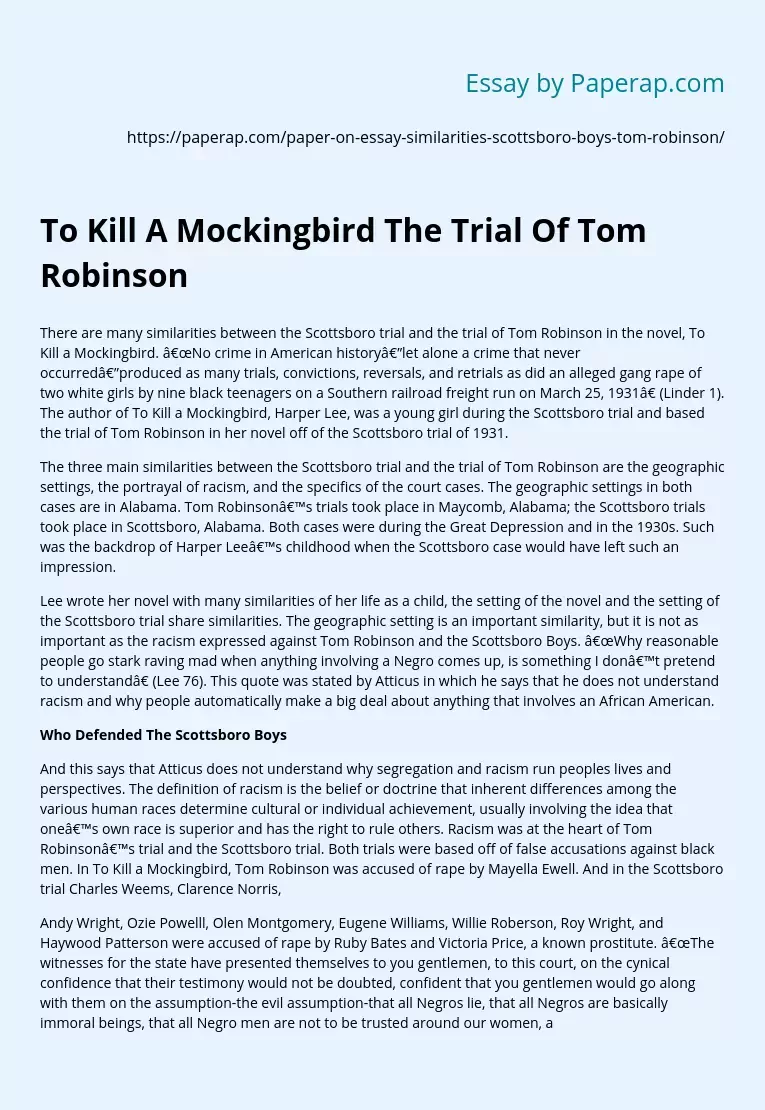To Kill A Mockingbird The Trial Of Tom Robinson
There are many similarities between the Scottsboro trial and the trial of Tom Robinson in the novel, To Kill a Mockingbird. “No crime in American history—let alone a crime that never occurred—produced as many trials, convictions, reversals, and retrials as did an alleged gang rape of two white girls by nine black teenagers on a Southern railroad freight run on March 25, 1931” (Linder 1). The author of To Kill a Mockingbird, Harper Lee, was a young girl during the Scottsboro trial and based the trial of Tom Robinson in her novel off of the Scottsboro trial of 1931.
The three main similarities between the Scottsboro trial and the trial of Tom Robinson are the geographic settings, the portrayal of racism, and the specifics of the court cases. The geographic settings in both cases are in Alabama. Tom Robinson’s trials took place in Maycomb, Alabama; the Scottsboro trials took place in Scottsboro, Alabama. Both cases were during the Great Depression and in the 1930s.
Such was the backdrop of Harper Lee’s childhood when the Scottsboro case would have left such an impression.
Lee wrote her novel with many similarities of her life as a child, the setting of the novel and the setting of the Scottsboro trial share similarities. The geographic setting is an important similarity, but it is not as important as the racism expressed against Tom Robinson and the Scottsboro Boys. “Why reasonable people go stark raving mad when anything involving a Negro comes up, is something I don’t pretend to understand” (Lee 76).
This quote was stated by Atticus in which he says that he does not understand racism and why people automatically make a big deal about anything that involves an African American.
Who Defended The Scottsboro Boys
And this says that Atticus does not understand why segregation and racism run peoples lives and perspectives. The definition of racism is the belief or doctrine that inherent differences among the various human races determine cultural or individual achievement, usually involving the idea that one’s own race is superior and has the right to rule others. Racism was at the heart of Tom Robinson’s trial and the Scottsboro trial. Both trials were based off of false accusations against black men. In To Kill a Mockingbird, Tom Robinson was accused of rape by Mayella Ewell. And in the Scottsboro trial Charles Weems, Clarence Norris,
Andy Wright, Ozie Powelll, Olen Montgomery, Eugene Williams, Willie Roberson, Roy Wright, and Haywood Patterson were accused of rape by Ruby Bates and Victoria Price, a known prostitute. “The witnesses for the state have presented themselves to you gentlemen, to this court, on the cynical confidence that their testimony would not be doubted, confident that you gentlemen would go along with them on the assumption-the evil assumption-that all Negros lie, that all Negros are basically immoral beings, that all Negro men are not to be trusted around our women, an assumption one associates with minds of their caliber” (Lee 204).
This quote was stated by Atticus in To Kill a Mockingbird in the court and he is stating the beliefs of most people in the south during the Great Depression. These trials took place during a time of segregation and racism so most people took the side of the white women. Both of the juries and judges for these trials were white. Because of this, the accused had no chance of getting equal treatment or justice. The last and most important similarity between the Tom Robinson trial and the Scottsboro trial is the similarities within the court.
The similarities within the courts are the most important similarities between the Tom Robinson trial and the Scottsboro trial. All of the accused African Americans were found guilty in both cases. “ A jury never looks at a defendant it has convicted, and when this jury came in, not one of them looked at Tom Robinson. The foreman handed a piece of paper to Mr. Tate who handed to the clerk who handed it to the judge . . . I shut my eyes. Judge Taylor was polling the jury: ‘Guilty . . . guilty . . . guilty . . . uilty . . . ’” (Lee 211). This quote is from To Kill a Mockingbird when Scout and Jem were waiting for the verdict of the jury. In both cases the trials were extremely long and both cases were false charges against African Americans during the 1930’s by lower class Caucasians. Atticus Finch, of To Kill a Mockingbird, and real-life attorney Samuel Leibowitz both defended the black accused victims. The trial of the Scottsboro boys and the trial of Tom Robinson in To Kill a Mockingbird share many similarities.
The three main similarities are the geographic settings, the portrayal of racism, and the certain specifics of the court cases. Having grown up during the convictions and trial of the Scottsboro boys, Harper Lee wrote and based her own trial off of the ones going on in Alabama in the 1930s. Harper Lee, author of To Kill a Mockingbird, wrote her novel to take place in Alabama; the same place she grew up and the same place the Scottsboro trial occurred. Racism was one of the biggest factors that took place in both trials; the words of white women against black men were the cause of both trials.
And the alikeness of the court cases such as the lawyers, defendants, accusations, and verdicts held the most important role in the similarities of the trials.
Works Cited Carter, Dan T. Scottsboro: A Tragedy of the American South. Baton Rouge: Louisiana State University Press, 1979. Lee, Harper. To Kill a Mockingbird. New York: J. B. Lippincott, 1960. Linder, Douglas O. “The Trials of the Scottsboro Boys. ”
To Kill A Mockingbird The Trial Of Tom Robinson. (2019, Dec 05). Retrieved from https://paperap.com/paper-on-essay-similarities-scottsboro-boys-tom-robinson/

